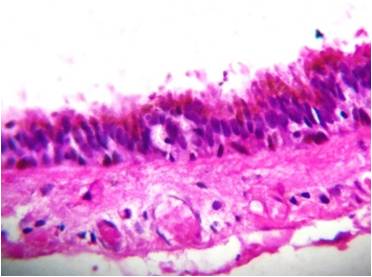Giant Apocrine Hidrocystoma of the Anogenital Region: A Case Report
Keywords:
apocrine gland, hidrocystoma, adnexal neoplasm
Abstract
Hidrocystomas are rare, benign, cystic lesions of the sweat glands. They result from proliferation of the apocrine secretory coil or eccrine duct. Hidrocystomas are of two types, apocrine and eccrine depending on the origin of the cyst. These commonly occur over the head and neck region and their size ranges from few millimeters to a centimeter in diameter. The tumours more than two centimeters in diameter are called as giant apocrine hidrocystoma. The occurrence of such giant apocrine hidrocystoma over the anogenital region is rare and we found that there is paucity of literatures regarding the apocrine hidrocystoma having atypical presentation. The differential diagnosis of the cystic neoplasms often poses a diagnostic challenge in this site.Hence, we present the case of giant apocrine hidrocystoma in a 23-year-old male patient measuring 2.5x2.3 cm in size and located in the anogenital region. The excisional biopsy of the lesion was performed. Histopathologically, the lesion showed double-layered secretary epithelium of apocrine type. Here, we discuss a rare case of giant apocrine hidrocystoma over the anogenital region and highlight its histopathological features and its close differential diagnosis of cystic lesions over the anogenital region.References
1. Kentaro K, Shuichi F, Harumi I, Yuji M, Fumio I, Kaoru K. Apocrine Hidrocystoma of the Lower Lip: A Case Report and Literature Review. Head and Neck Pathol 2014; 8:117–121.
2. Prabhu A, Prabhu M, Niranjan K, Grampurohit UV. Recurrent giant apocrine hidrocystoma of the eyelid: A case report. Egyptian Dermatology Online Journal 2014; 10;10.
3. Vani D, Dayananda T R, Shashidhar HB, Bharathi M, Hareesh R S Kumar, V Ravikumar. Multiple Apocrine Hidrocystomas: A Case Report. Journal of Clinical and Diagnostic Research 2013;7:171-72.
4. Choudhary S, Suba G, Ramesh BS, Shanmukan MB. Hydrocystoma of eyelid: a case report. Int. J. Curr. Res. Aca. Rev 2015;3:159-61.
5. Mehregan AH. Apocrine cystadenoma, a clinicopatholoical study with special reference to the pigmented variety. Arch Dermatol 1964;90: 274-79.
6. Rapini RP. Apocrine Hidrocystoma. http://www.emedicine.com/derm/ topic35.htm.
7. Vashi N, Mandal R. Giant multi-loculated apocrine hidrocystomas. Dermatol Online J 2010;16:16
8. Choudhary S, G Suba, BS Ramesh and MB Shanmukan. Hydrocystoma of eyelid: a case report. Int. J. Curr. Res. Aca. Rev. 2015; 3(3): 159-61.
9. Yi-Shan L, Jyh-Seng W, Tzong-Shiun L. A 25-year-old man with a dome-shaped translucent nodule on the glans penis. Dermatologica Sinica. 2010; 28:177–78.
10. Vishwapriya.M.G ,Darshan.P.M, Deshpande.S.A , Suvernekar.S.V. Syringocystadenoma Papilliferum-Case Report. IOSR Journal of Dental and Medical Sciences 2013; 5(1):43-6.
2. Prabhu A, Prabhu M, Niranjan K, Grampurohit UV. Recurrent giant apocrine hidrocystoma of the eyelid: A case report. Egyptian Dermatology Online Journal 2014; 10;10.
3. Vani D, Dayananda T R, Shashidhar HB, Bharathi M, Hareesh R S Kumar, V Ravikumar. Multiple Apocrine Hidrocystomas: A Case Report. Journal of Clinical and Diagnostic Research 2013;7:171-72.
4. Choudhary S, Suba G, Ramesh BS, Shanmukan MB. Hydrocystoma of eyelid: a case report. Int. J. Curr. Res. Aca. Rev 2015;3:159-61.
5. Mehregan AH. Apocrine cystadenoma, a clinicopatholoical study with special reference to the pigmented variety. Arch Dermatol 1964;90: 274-79.
6. Rapini RP. Apocrine Hidrocystoma. http://www.emedicine.com/derm/ topic35.htm.
7. Vashi N, Mandal R. Giant multi-loculated apocrine hidrocystomas. Dermatol Online J 2010;16:16
8. Choudhary S, G Suba, BS Ramesh and MB Shanmukan. Hydrocystoma of eyelid: a case report. Int. J. Curr. Res. Aca. Rev. 2015; 3(3): 159-61.
9. Yi-Shan L, Jyh-Seng W, Tzong-Shiun L. A 25-year-old man with a dome-shaped translucent nodule on the glans penis. Dermatologica Sinica. 2010; 28:177–78.
10. Vishwapriya.M.G ,Darshan.P.M, Deshpande.S.A , Suvernekar.S.V. Syringocystadenoma Papilliferum-Case Report. IOSR Journal of Dental and Medical Sciences 2013; 5(1):43-6.

Published
2016-02-29
Issue
Section
Case Report
Authors who publish with this journal agree to the following terms:
- Authors retain copyright and grant the journal right of first publication with the work simultaneously licensed under a Creative Commons Attribution License that allows others to share the work with an acknowledgement of the work's authorship and initial publication in this journal.
- Authors are able to enter into separate, additional contractual arrangements for the non-exclusive distribution of the journal's published version of the work (e.g., post it to an institutional repository or publish it in a book), with an acknowledgement of its initial publication in this journal.
- Authors are permitted and encouraged to post their work online (e.g., in institutional repositories or on their website) prior to and during the submission process, as it can lead to productive exchanges, as well as earlier and greater citation of published work (See The Effect of Open Access at http://opcit.eprints.org/oacitation-biblio.html).




